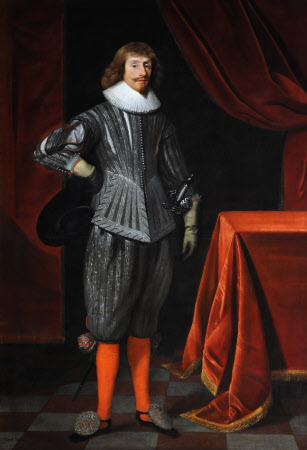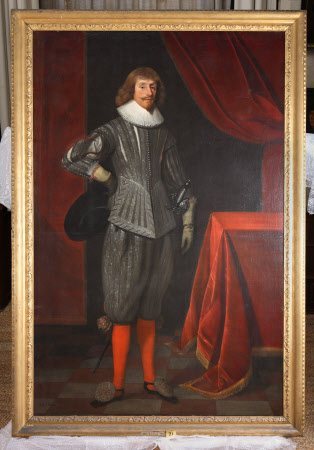Thomas Bruce, 3rd Lord Bruce of Kinloss, 1st Earl of Elgin (1599-1663)
after Daniel Mytens the elder (Delft c.1590 – The Hague 1648) and Studio
Category
Art / Oil paintings
Date
circa 1630 - 1663
Materials
Oil on canvas
Measurements
2180 x 1430 mm
Place of origin
England
Order this imageCollection
Hardwick Hall, Derbyshire
NT 1129163
Caption
Thomas, Lord Bruce of Kinloss, and 1st Earl of Elgin, born in Edinburgh, was the third son of Edward Bruce, 1st Lord of Kinloss and Magdalen Clerk, daughter of Sir Alexander Clerk. He succeeded his elder brother in the Scottish Barony in 1613 on the death of his father in a famous duel with Sir Edward Sackville, later 4th Earl of Dorset (1590-1652). He attended the King into Scotland in 1633 and was created Earl of Elgin. He married firstly, in 1622, Anne Chichester (1605-1627), only daughter of Sir Robert Chichester, of Raleigh in Devon, and secondly, Diana Cecil, Countess of Oxford and Elgin (1596-1654), daughter of William Cecil, 2nd Earl of Exeter (d.1640). His sister, Christian Bruce (1595-1675), married William Cavendish, 2nd Earl of Devonshire (1590-1628). Demonstrably the same figure was painted by Cornelis Jonson in 1638, in a portrait from Redlynch, and now at Ranger's House.
Summary
Oil painting on canvas, Thomas Bruce, 3rd Lord Bruce of Kinloss, 1st Earl of Elgin (1599 - 1663), after Daniel Mytens the elder (Delft c.1590 - The Hague 1648) and Studio. A full-length portrait, turned slightly to the right, standing by a table covered with a red cloth, his right hand with his hat on his hip; he wears a grey dress embroidered with lines of silver braid, and red hose.
Provenance
Seen by Horace Walpole at Chatsworth in 1760; in Lady Louisa Cavendish 1860 catalogue of Hardwick Hall; and thence by descent until, following the death of Edward William Spencer Cavendish, 10th Duke of Devonshire (1895 - 1950), Hardwick Hall and its contents were accepted by HM Treasury in part payment of death duties and transferred to the National Trust, in 1959
Marks and inscriptions
in black, bottom left, Lord Bruce
Makers and roles
after Daniel Mytens the elder (Delft c.1590 – The Hague 1648) and Studio, artist

